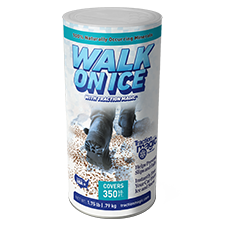5 Winter Maintenance Hacks For Stamped Concrete Driveway
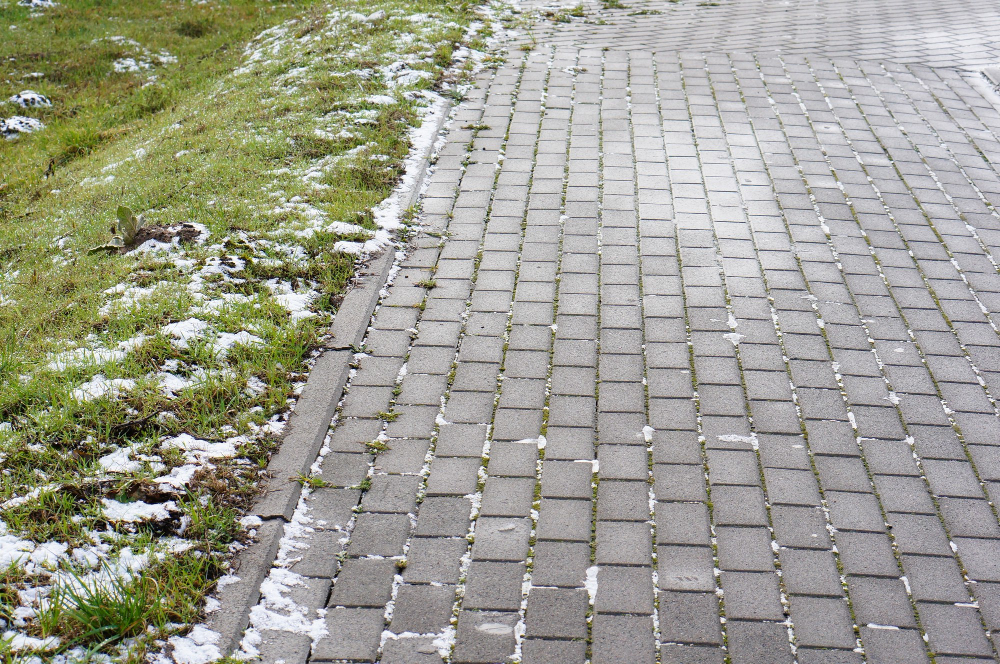
When the winter months arrive, it’s important to prepare your concrete driveway for the cold weather. Preparing your stamped concrete can help prevent damage, extend its life, and keep it looking beautiful.
How Is Stamped Concrete Done?
Stamped concrete is achieved by pouring a mixture of concrete, colorants, and additives onto the surface and then imprinting it with stamps that resemble natural materials like stone, brick, or wood. The result is a decorative, textured finish.
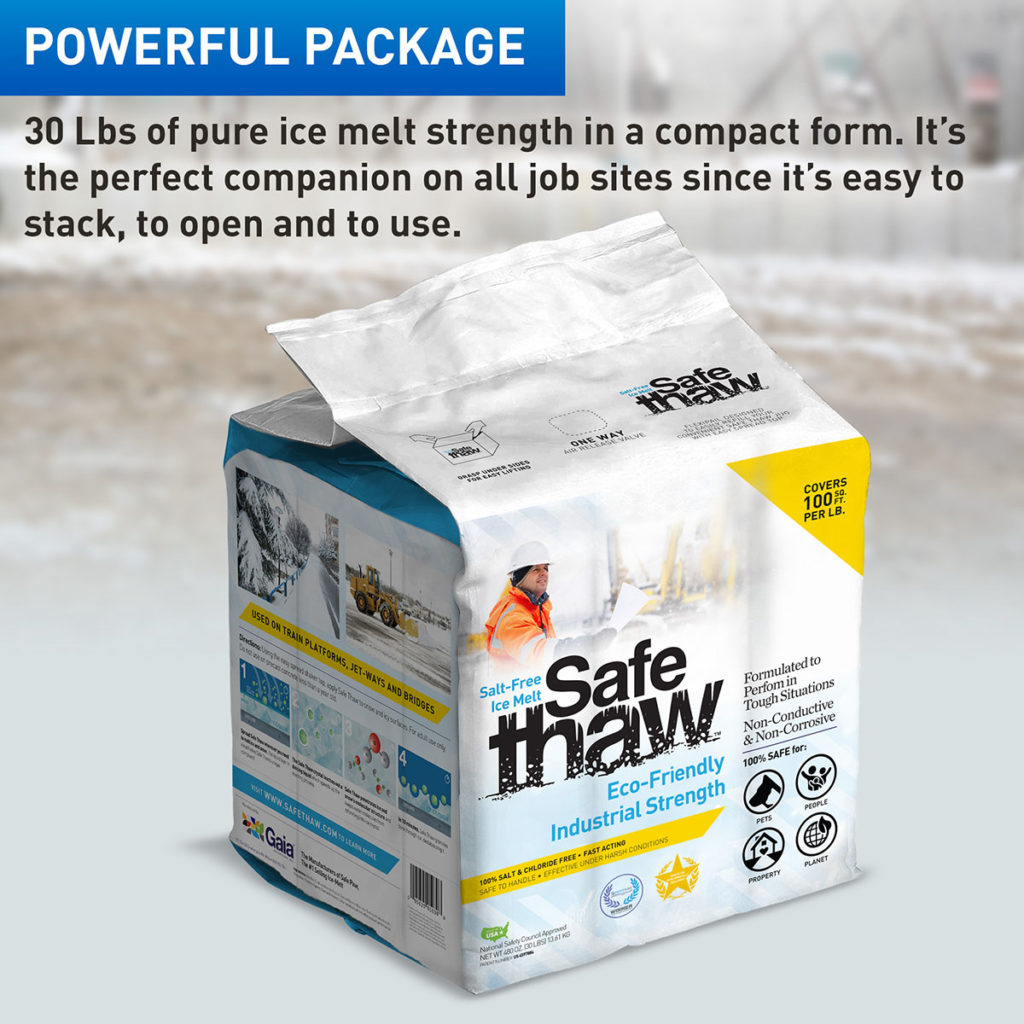
Safe Thaw
Safe Thaw was created as the ice management solution for tough winter environments. Ideal in commercial and industrial properties, shops, government agencies, bridges, and construction.
Concrete Safe Ice Melt: Winter Maintenance Tips for Stamped Concrete Driveways
Stamped concrete driveways enhance the aesthetic appeal of your property but require careful maintenance, especially in winter. Harsh weather, deicing salts, and freeze-thaw cycles can lead to significant damage. This guide covers practical tips to keep your stamped concrete driveway looking great and structurally sound all winter long.
The Impact of Deicing Salts on Stamped Concrete
Why Deicing Salts Are Harmful
Traditional deicers, such as sodium chloride and calcium chloride, are effective at melting ice but pose a risk to stamped concrete driveways:
- Scaling and Spalling: These salts accelerate water absorption into the concrete, causing the surface to flake and chip.
- Chemical Deterioration: Chlorides can chemically interact with the concrete mix, weakening its structural integrity.
- Surface Staining: Over time, the salts can leave unsightly stains, diminishing the visual appeal of stamped patterns.
Choosing Concrete Safe Ice Melt
Using chloride-free and non-corrosive products like Safe Thaw prevents these damages. It ensures effective ice melting while preserving the integrity and appearance of your driveway.
The Importance of Regular Sealing
Benefits of Sealing Stamped Concrete
Applying a high-quality sealer every 2–3 years provides:
- Moisture Protection: Sealers create a barrier that reduces water penetration, mitigating freeze-thaw damage.
- Enhanced Durability: A sealed surface resists cracking, scaling, and spalling.
- Aesthetic Preservation: Sealers maintain the vibrant color and pattern of stamped concrete.
Tips for Proper Sealing
- Clean the surface thoroughly before application.
- Apply the sealer in mild, dry weather conditions for optimal adherence.
- Choose sealers compatible with ice melter concrete safe products to ensure long-lasting results.
Preventing Freeze-Thaw Cycle Damage
How Freeze-Thaw Cycles Affect Concrete
When water seeps into small pores and freezes, it expands, exerting internal pressure. Repeated cycles lead to:
- Cracks in the surface.
- Loosening of stamped patterns.
- Accelerated wear and tear.
Strategies to Minimize Damage
- Ensure Proper Drainage: Direct water away from your driveway to reduce pooling.
- Prompt Snow Removal: Clear snow before it compresses into ice.
- Use of Concrete Safe Ice Melt: Products like Safe Thaw reduce ice formation without exacerbating moisture issues.
Environmental and Pet Safety Considerations
The Environmental Cost of Traditional Deicers
- Chloride-based deicers pollute water sources, harming aquatic life.
- Sodium chloride increases soil salinity, affecting nearby plants.
The Importance of Pet-Safe Solutions
- Traditional deicers can irritate paws and harm pets if ingested.
- Eco-friendly and pet-safe options like Safe Thaw:
- Prevent chemical burns.
- Eliminate risks associated with ingestion.
- Protect surrounding vegetation and groundwater.
Long-Term Maintenance Practices for Stamped Concrete
Regular Cleaning and Inspection
- Sweep debris regularly to prevent scratches.
- Use mild soap and water for stain removal.
- Inspect for small cracks or chips, and address them promptly.
Seasonal Maintenance
- Apply protective sealants before winter to guard against moisture damage.
- Use the best ice melt, like Safe Thaw, during snow and ice events to prevent harm to the concrete surface.
Preventative Care for Longevity
- Avoid using metal shovels that can scratch or chip the surface.
- Protect heavy-traffic areas with mats or rugs during harsh weather conditions.
Follow these tips in order to keep your driveway in top shape through winter and beyond:
- Inspect Your Concrete: The most important thing you can do to protect your concrete is to inspect it. The winter months are cold and hard on a driveway, so take a close look at the surface of your concrete. Look for cracks, chips, and other damages caused by freezing temperatures in previous winters. Also, check for ruts and depressions on the surface—a sure sign that water has been pooled on your driveway during heavy rains or snow melt/freeze cycles. And make sure there are no signs of frost heaving (when moisture seeps into the ground below and expands as it freezes).
- Maintain A Clean Surface: You should maintain a clean surface, using a power washer and broom to remove dirt, dust, and debris. A leaf blower can be used to remove leaves and other materials from the stamped concrete driveway.
- Use Ice Melt Products Appropriately: Use products that are safe for concrete. Many ice melts contain harmful chemicals, so check the label before buying a product. One of the most common chemicals in ice melts is calcium chloride, which can be harmful to concrete and other surfaces like grass and vegetation, but it’s safe for pets and children.
- Use A Safe Ice Melt For Concrete Pavers: Safe Thaw by Gaia is a biodegradable ice melter made from all-natural ingredients. It’s safe for pets and children. So you can use it inside your home and outside on concrete surfaces. Safe Thaw by Gaia does not harm plants or grasses because it does not contain sodium chloride (which is present in rock salt and other conventional deicers). Safe Thaw contains modified urea as its main active ingredient. Potassium chloride also helps prevent corrosion of metal pipes and fittings that could be vulnerable to damage from traditional deicers that contain sodium chloride or calcium chloride.
- Seal All Concrete Surfaces: Sealing your concrete surface is the most effective technique to maintain its flawless condition over time. Doing so before winter ensures that it won’t get damaged when moisture comes into contact with the surface of your concrete slab.
- Use Ice Melt Safe For Stamped Concrete: Safe Thaw is the best ice melt safe for stamped concrete and is eco-friendly, non-toxic, and biodegradable. Safe Thaw is a urea-modified product with special surfactants, glycols, ice melting boosters, and inhibitors. However, we do not recommend using ice melt products on concrete that’s less than 12 months old.
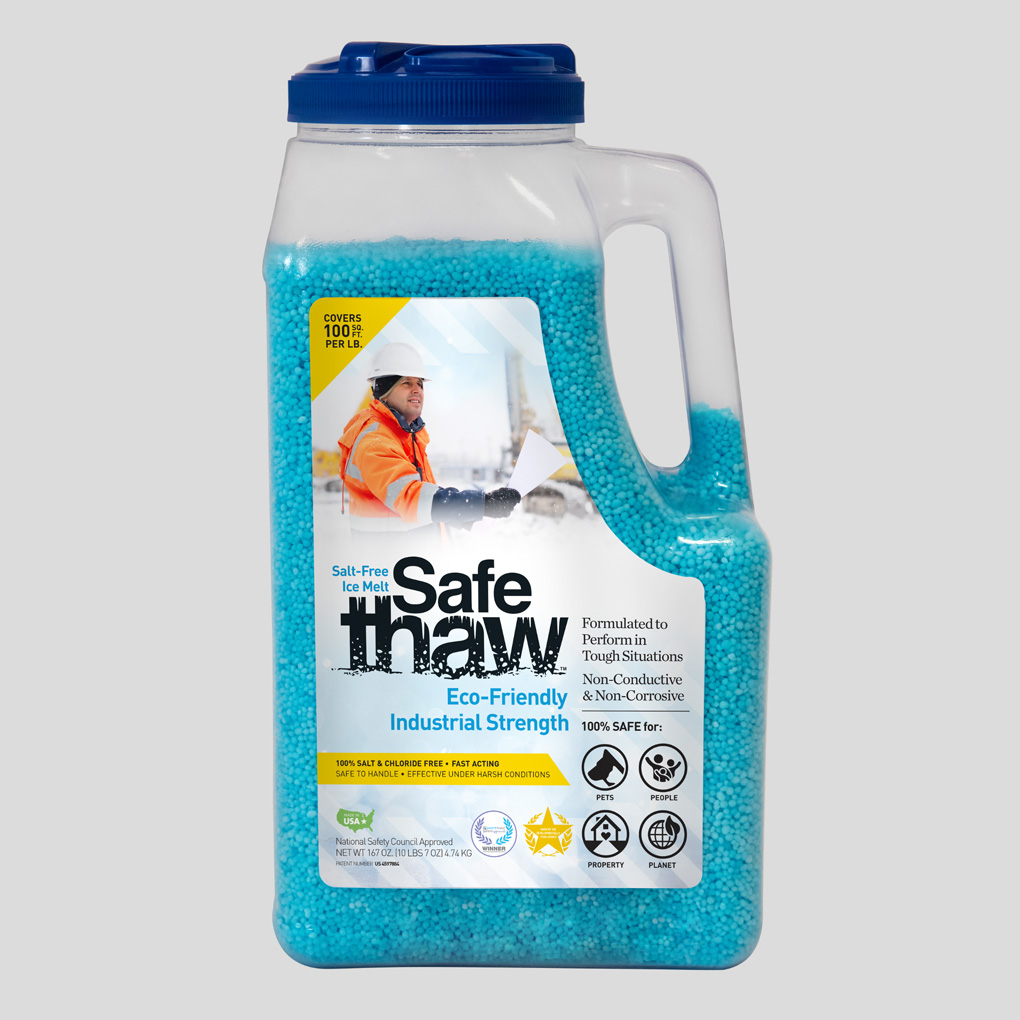
Safe Thaw
Safe Thaw was created as the ice management solution for tough winter environments. Ideal in commercial and industrial properties, shops, government agencies, bridges, and construction.
Stamped Concrete Maintenance:
To maintain the allure of your stamped concrete, follow these steps:
- Regular Cleaning: Sweep away debris regularly to prevent surface scratches. Use a gentle detergent and water solution for occasional deep cleaning.
- Avoid Harsh Chemicals: Refrain from using acidic or abrasive cleaners, as they can damage the sealant and color of the stamped concrete.
- Sealing: Apply a quality sealer every 2-3 years to protect the surface from water infiltration, UV rays, and staining.
- Preventative Measures: Place rugs or mats near entrances to minimize tracking of debris onto the stamped concrete surface.
Chipping In Stamped Concrete
Stamped concrete maintenance is one thing, chipping is another. Chipping in stamped concrete can occur due to various factors, including improper installation, poor quality sealants, or extreme temperature changes. Regular maintenance and proper care can prevent chipping and maintain the integrity of the surface.
Understanding White Spots on Stamped Concrete
Have you ever noticed white spots on stamped concrete after winter? They can look like cloudy patches or chalky stains that dull the beauty of the driveway. These spots usually occur when deicing chemicals seep into the pores of the concrete, leaving residue after the water evaporates. Sometimes, it’s just efflorescence—a deposit of salts that naturally migrate to the surface. Other times, it can signal more serious scaling or moisture-related damage.
So, how do you know the difference? If the white patches disappear when wet but return after drying, you’re likely dealing with efflorescence. In that case, gentle cleaning with a mild detergent and resealing the driveway can usually solve the problem. But if the spots look like permanent etching, they could be chemical burns from harsh products. That’s why sealing and using a concrete-safe ice melt is non-negotiable for stamped finishes.
Repair and Repainting Options for Stamped Concrete
When discoloration or surface wear becomes too visible, repainting concrete driveway surfaces is an option. Recoloring products and tinted sealers can revive faded patterns and cover mild blotching. This is especially helpful for decorative finishes like stamped concrete that rely heavily on consistent color tones for their appeal.
But repainting alone won’t fix underlying cracks or scaling. That’s where a combination of patching and sealing comes in. You might wonder, “Can you resurface concrete driveway instead of replacing it?” The answer is yes—if the foundation is intact. Concrete resurfacing products can be applied in thin layers over existing stamped concrete, restoring smoothness and appearance without tearing the whole slab out. It’s often more cost-effective, especially if you’ve invested in decorative finishes you’d rather preserve.
Practical Fixes for Cracks and Chips
Driveways, stamped or not, eventually develop cracks. But the key is knowing the best way to fill cracks in concrete driveway surfaces before they expand. For hairline cracks, liquid crack fillers or polymer-based sealants do the job well. For deeper fractures, use a concrete patching compound applied with a trowel. Always clean out dirt and debris first to ensure proper adhesion.
Some homeowners try quick DIY fixes with household sealants, but these rarely hold up against winter freeze-thaw cycles. Instead, invest in professional-grade products meant for exterior use. A good repair not only prevents water intrusion but also helps maintain the integrity of stamped designs. For chips along edges or steps, patching with color-matched material can help preserve aesthetics.
Cost Factors: Per Square Foot vs. Long-Term Maintenance
One of the most common questions people ask is: “What’s the real cost of a stamped concrete driveway?” While the upfront price per square foot can range higher than asphalt or plain concrete, the long-term maintenance often makes it worth the investment. On average, a concrete driveway per square foot costs between $8 and $18, depending on design complexity and region.
But here’s the catch—your maintenance habits significantly impact the value. Regular sealing, careful snow removal, and using products like Safe Thaw to manage ice help protect that investment. Neglect it, and you might find yourself spending thousands on resurfacing or repairs. In other words, the true “cost” isn’t just about installation—it’s about upkeep.
100% salt & chloride-free, fast acting Ice Management Solution
Conclusion
Stamped concrete driveways are as much about beauty as they are about function. But maintaining that blend requires vigilance. From dealing with white spots on stamped concrete to deciding whether to patch, repaint, or resurface, your choices shape how long your driveway retains its charm. Repairing cracks promptly, resealing every few years, and choosing safe products all help prevent small issues from spiraling into costly replacements.
And when it comes to winter, there’s simply no room for shortcuts. Chloride-based deicers may promise quick results, but they leave behind years of invisible damage. That’s why Safe Thaw stands out—it’s not just concrete-safe, it’s also a smarter choice for large-scale industrial and commercial applications. Whether you’re managing stamped concrete around a retail entrance, a municipal walkway, or a residential driveway, Safe Thaw ensures ice melts quickly without etching, scaling, or harming the surface.
So, if you’re weighing the best way to fill cracks in concrete driveway or wondering can you resurface concrete driveway instead of replacing it?—remember this: prevention is always less expensive than repair. With consistent sealing, timely fixes, and chloride-free ice melt, your stamped concrete driveway can remain both stunning and sturdy for decades.
FAQs
Try Also Our Other Winter Safety Products:
Traction Magic
Stay safe on slippery surfaces with a product that’s 100% natural and safe for pets, people, and your property. Whether it’s sidewalks, steps, or even your car’s traction, Traction Magic is the go-to choice.
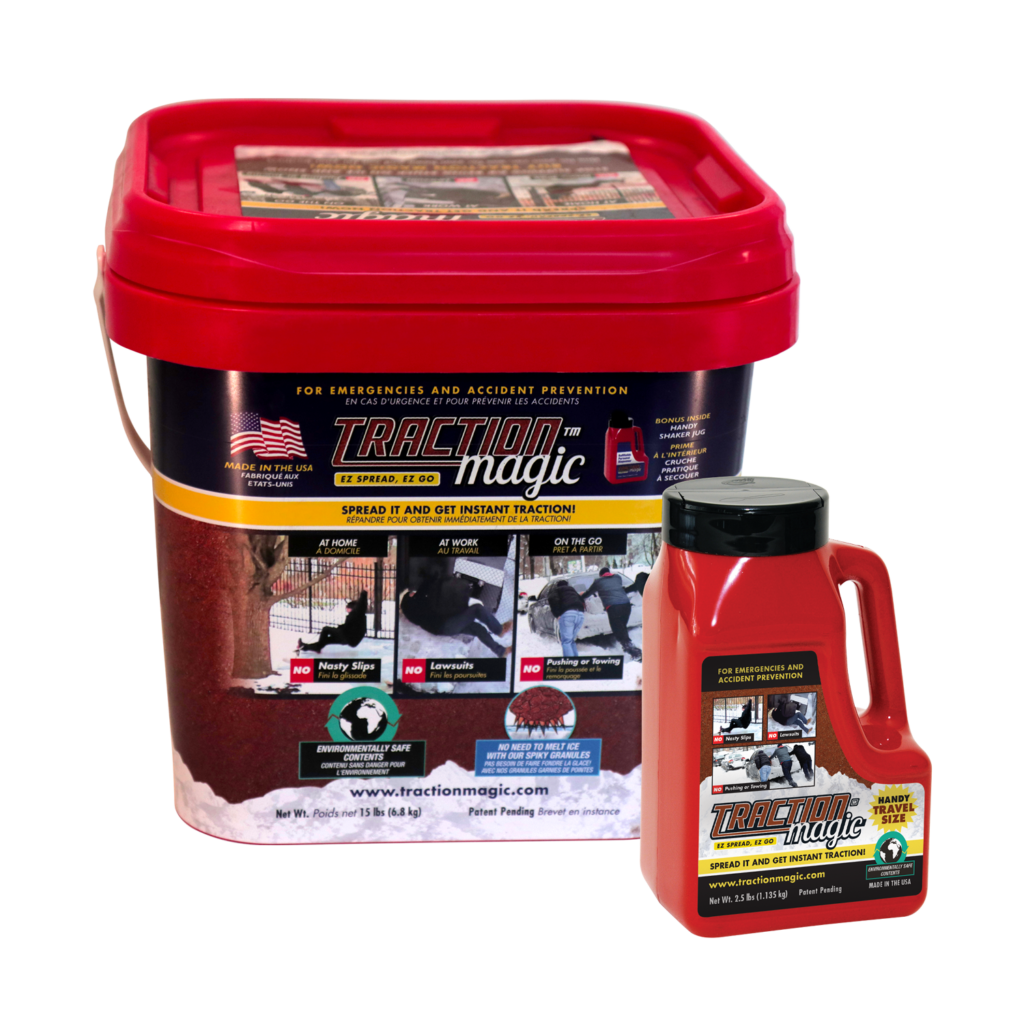
Walk On Ice
The handy disposable canister can be taken everywhere, with the same 100% naturally occurring minerals that provide instant traction on ice or snow. Use it on sidewalks, steps, or as an instant traction agent for your car.
